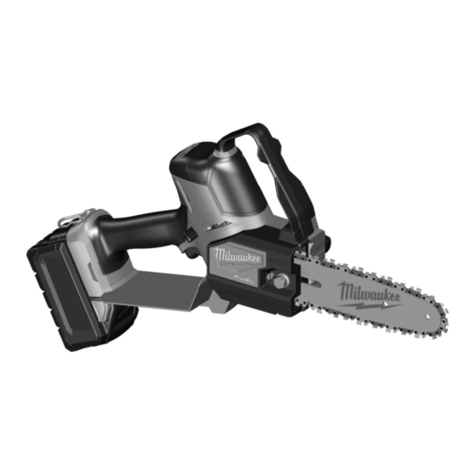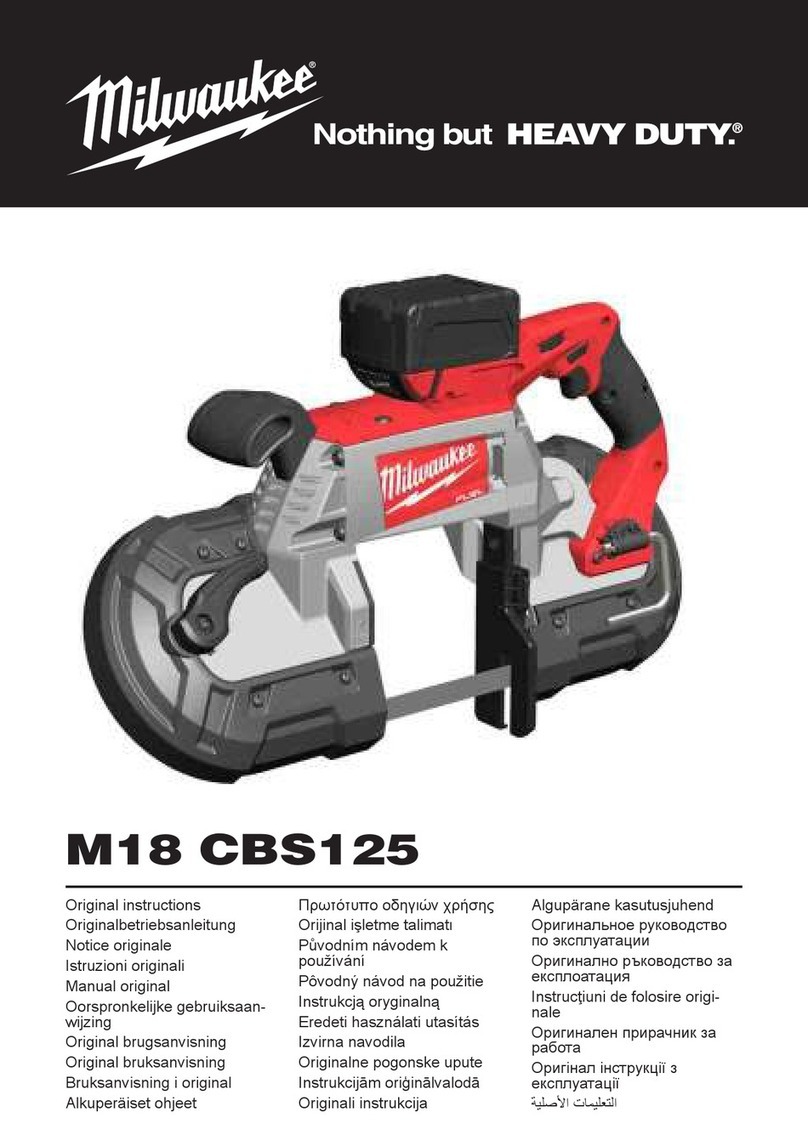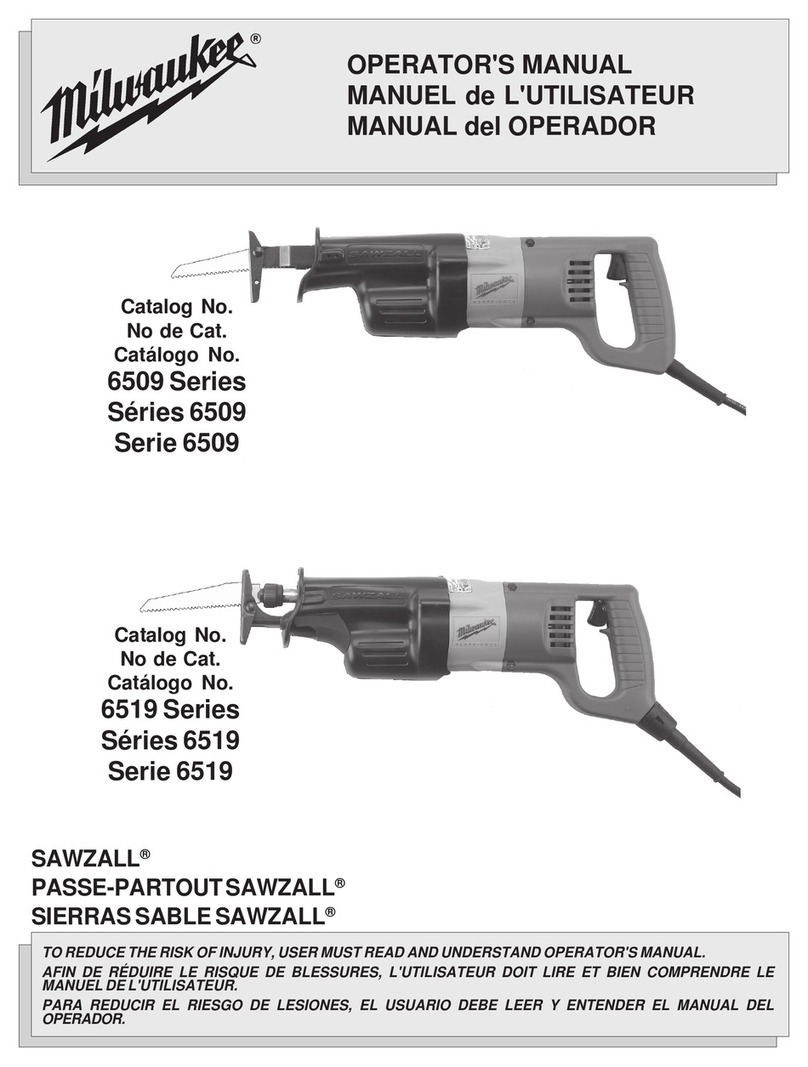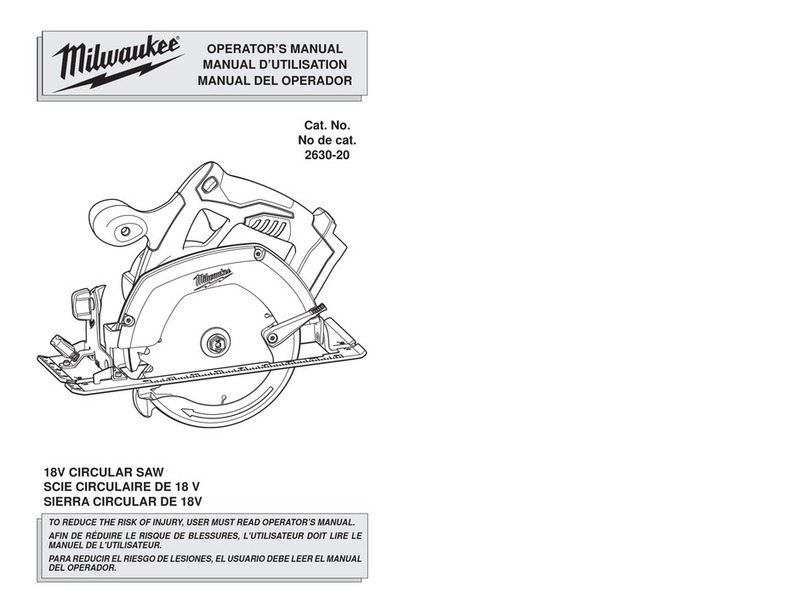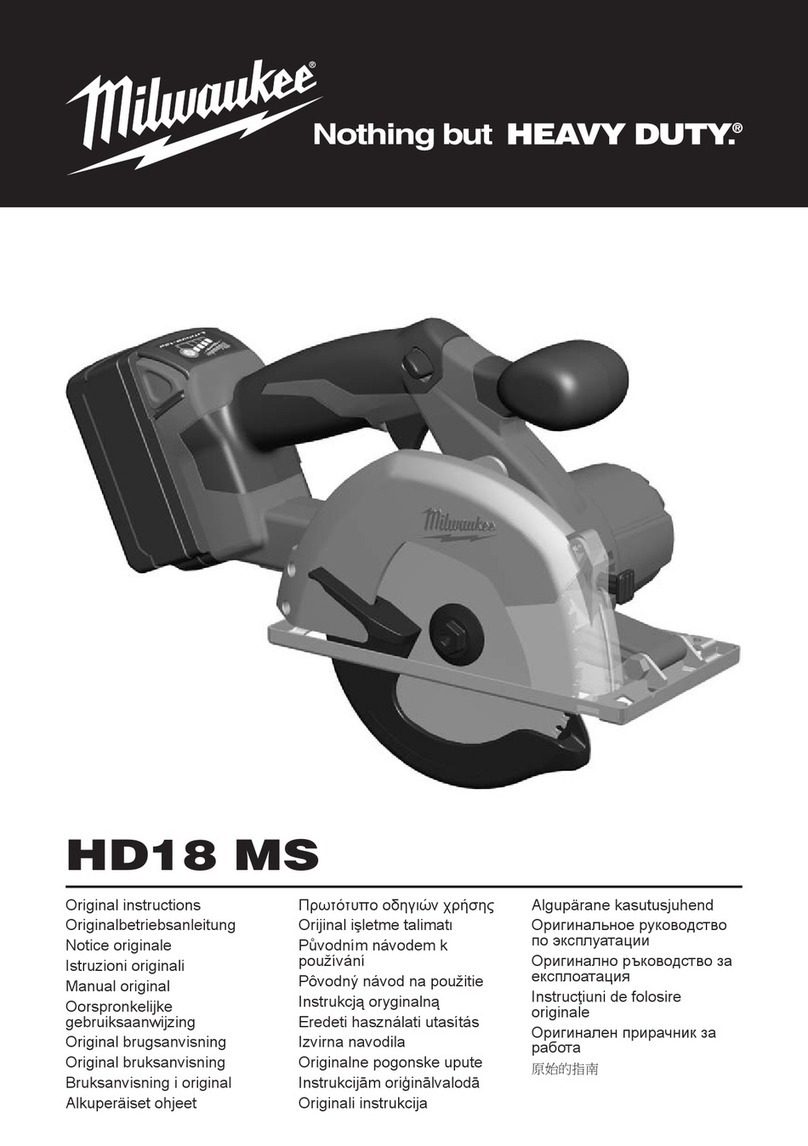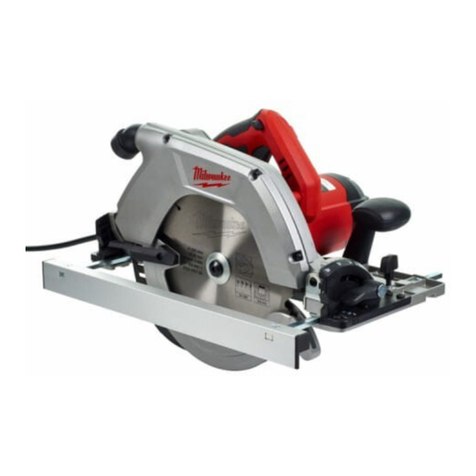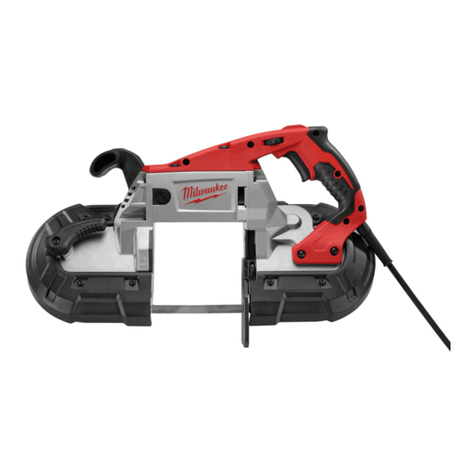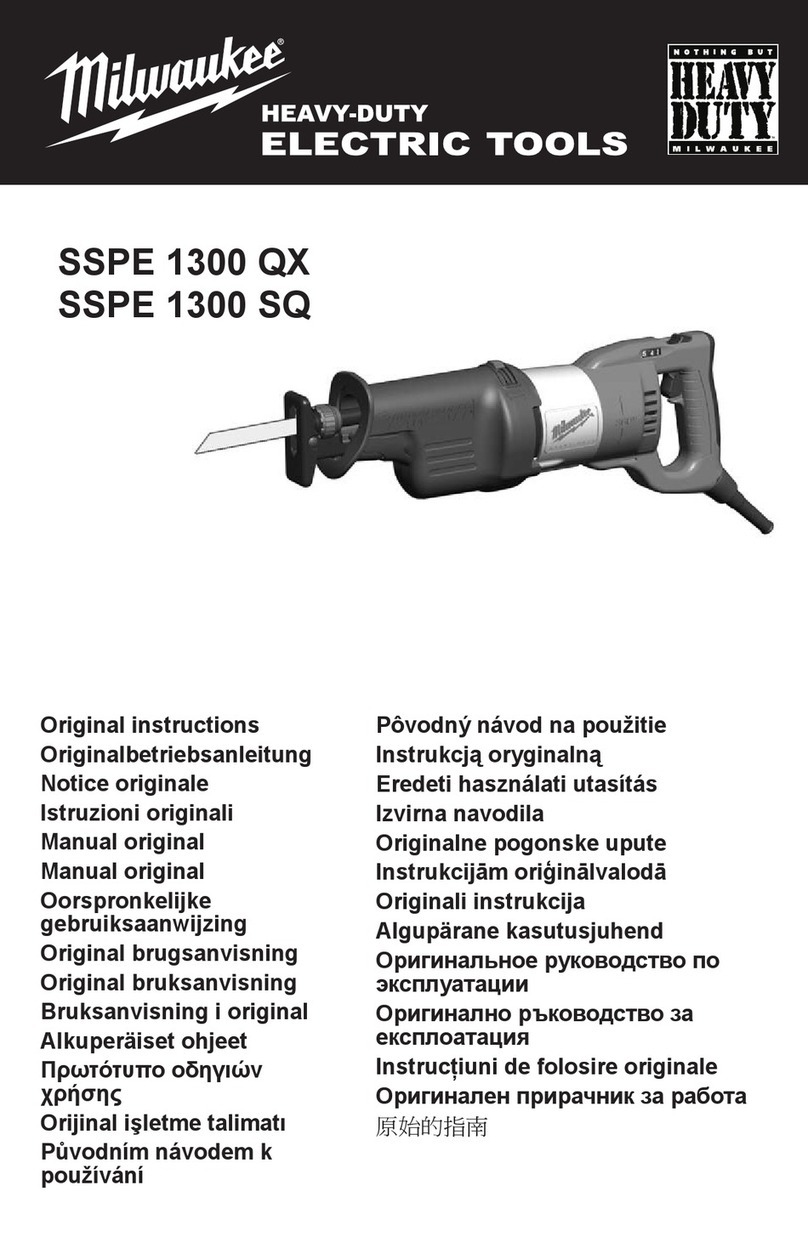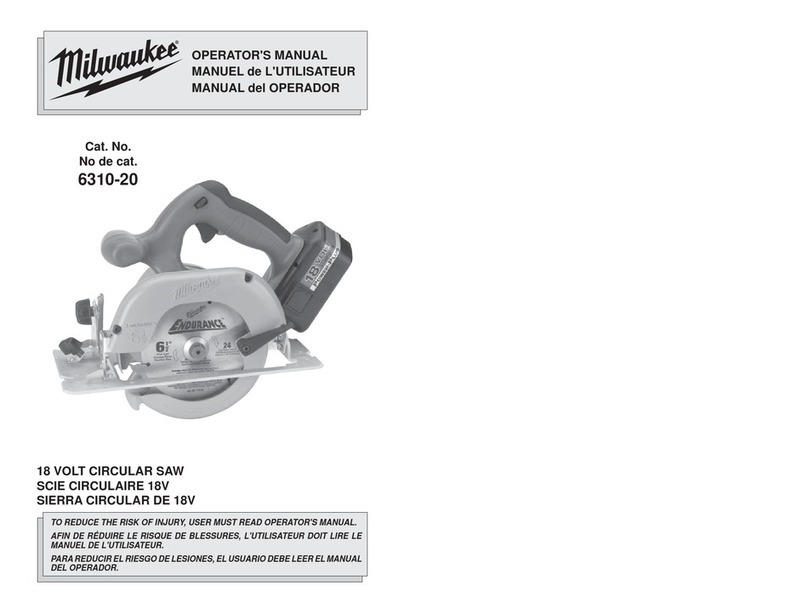GENERAL
POWER
TOOL
SAFETY
WARNINGS
ML WARNING
READ
ALL
SAFETY
WARNINGS AND ALL INSTRUCTIONS. Failureto
followthe
warnings
and
Instructions
may
result
in
electric
shock,
fire
and/or
serious
injury.
Save
all
warnings
and
instructions
for
future
reference.
The
term
"power
tool"
in
the
warn-
ings
refers
toyour
mains-operated
(corded)powertoolorbattery-operated
(cordless)
powertool.
WORK
AREA
SAFETY
•Keep
workareacleanandwelllit.Clutteredor
dark
areas
invite
accidents.
•Donotoperatepowertoolsinexplosiveatmos-
pheres,
such
asinthepresenceofflammable
liquids,
gases
or
dust.
Power
tools
create
sparks
which
mayignitethedustorfumes.
•Keep
childrenand
bystanders
awaywhileoper-
atinga powertool.
Distractions
can
cause
youto
lose
control.
- -
I
ELECTRICAL
SAFETY
I
•Power
toolplugsmustmatchtheoutlet.Never
modifythepiuginanyway.Donotuseany
adapterplugs
with
earthed(grounded)power
tools.
Unmodifiedplugsandmatchingoutletswill
reduce
riskof
electric
shock.
•Avoidbodycontact
with
earthedorgrounded
surfaces
such
aspipes,radiators,rangesand
refrigerators.There
is
an
increased
risk
of
electric
shock
ifyourbody
is
earthedorgrounded.
•Donot
expose
powertoolstorainorwet
condi-
tions.
Waterenteringa power
tool
will
increase
the
risk
of
electric
shock.'
•Donotabusethecord.Neverusethecordfor
carrying,
pullingorunpluggingthepowertooi.
Keep
cordaway
from
heat,oil,sharpedges
ormovingparts.Damagedorentangledcords
increase
theriskof
electric
shock.
•Whenoperatinga powertooloutdoors,usean
extension
cordsuitableforoutdoor
use.
Use
of
a
cordsuitableforoutdooruse
reduces
theriskof
electric
shock.
•Ifoperatinga powertoolina dampiocationis
unavoidable,
usea groundfaultcircuitinter-
rupter
(GFCi)
protectedsupply.Useofan
GFCi
reduces
the
risk
of
electric
shock.
I
PERSONAL
SAFETY
I
•Stay
alert,watchwhatyouaredoinganduse
common
sense
when
operatinga power
tool.
Do
not
use
a
power
tool
while
you
aretiredorunder
theinfluenceof
drugs,
alcoholor
medication.
A
momentofinattentionwhileoperatingpowertools
mayresultin
serious
personal
injury.
•Use
personalprotectiveequipment.Always
weareyeprotection.Protectiveequipment
such
as
dust
mask,
non-skidsafety
shoes,
hardhat,or
hearingprotectionusedforappropriateconditions
willreduce
personal
injuries.
• ' - - '
•Prevent
unintentionalstarting.
Ensure
the
switch
isintheoff-positionbeforeconnecting
topowersourceand/orbatterypack,picking
uporcarryingthetooi.Carryingpower
tools
with
your
finger
on
the
switch
or
energising
powertools
that
havethe
switch
oninvites
accidents.
•Remove
anyadjustingkeyorwrenchbefore
turningthepower
tooi
on.
A
wrench
ora key
left
attachedtoa rotatingpartofthepowertoolmay
result
in
personalinjury.
•Donot
overreach.
Keepproperfootingandbai-
ance
at
all
times.
This
enables
better
control
ofthe
powertoolinunexpectedsituations.
•Dress
properly.Donotwearlooseclothingor
jewellery.Keepyourhair,clothingandgloves
away
from
moving
parts.
Loose
clothes,
jewellery
orlonghair
can
becaughtinmovingparts.
•Ifdevicesareprovidedfortheconnectionof
dust
extractionandcoliectionfacilities,ensure
these
areconnectedandproperty
used.
Useof
dust
collection
canreducedust-related
hazards.
IPOWER
TOOL
USE AND
CARE
~]
•Donotforcethepowertool.Usethecorrect
power
tooi
for
your
application.
The
correct
power
tooi
willdothejobbetterandsaferattheratefor
which
it
was
designed.
•Donot
use
thepowertoolIfthe
switch
doesnot
turnitonandoff.Anypower
tooi
that
cannotbe
controlled
with
the
switch
is
dangerous
and
must
be
repaired.
•Disconnect
thepiug
from
thepower
source
and/
orthebatterypack
from
thepowertoolbefore
makingany
adjustments,
changing
accessories,
orstoringpowertoois.
Such
preventivesafety
measures
reduce
the
risk
of
starting
thepowertool
accidentally.
•Store
idlepowertooisoutofthereachof
chil-
drenanddonotallow
persons
unfamiliar
with
thepower
tooi
ortheseinstructionstooperate
thepowertooi.Power
tools
aredangerousinthe
hands
ofuntrained
users;
•Maintain
power
toois.
Check
formisalignmentor
bindingofmovingparts,breakageofpartsand
any
othercondition
that
mayaffectthepower
tool'soperation,if
damaged,
have
thepower
tooi
repairedbeforeuse.
Many
accidents
are
caused
bypoorlymaintainedpowertools.
•Keep
cuttingtoolssharpand
clean.
Properly
maintainedcuttingtools
with
sharpcuttingedges
are
less
likelytobindandare
easier
tocontrol.
•Use
thepowertooi,
accessories
andtoolbits
etc.
in
accordance
with
these
instructions,
tak-
inginto
account
theworkingconditionsandthe
worktobeperformed.Useofthepowertoolfor
operations
different
from
those
intended
couid
result
ina hazardoussituation.- •
I
^'SERVICE
I
•Haveyourpowertoolservicedbya qualified
repairpersonusingonlyidenticalreplacement
parts.
This
will
ensure
that
thesafetyofthepower
toolismaintained.' - • •
{
SPECIFIC
SAFETYRUL^~~]
Cuttingprocedures
•ADANGER:
Keephandsaway
from
cutting
area
andtheblade.Keepyour
second
handon
auxiliary
handle,
ormotor
housing.
If
both
hands
are
holding
the
saw,
they
cannot
be
cut
by
the
blade.
•Donotreachunderneaththeworkplace.The
guard
cannot
protect
you
from
thebladebelowthe
workpiece.
..n:,.
•Adjust
thecuttingdepthtothe
thickness
ofthe
workpiece.
Less
thana
full
tooth
of
the
bladeteeth
should
be
visible
below
the
workpiece.
:
I
'
l r
•Never,holdpiecebeingcutinyourhandsor
across
your
leg.
Secure
the
workpiece
to
a
stable
platform,it
is
important
to
support
the
workproperly
tominimizebody
exposure,
bladebinding,or
loss
of
control.
rv./..J
•HoldthepowertoolbyInsulated.gripping
sur-
faces
only,
whenperforming
an
operationwhere
thecutting
tooi
maycontacthiddenwiringorits
own
cord.
Contact
with
a
"live"
wirewill
also
make
exposed
metalpartsofthepowertool"live"and
could
givetheoperatoraneiectric
shock.
;
•Whenripping,
always
use
a ripfenceorstraight
edgeguide.
This
improves
the
accuracy
of
cut
and
reduces
the
chance
ofbladebinding.'-
'
•Always
useblades
with
correct
size
andshape
(diamond
versus
round)ofarbour
holes;
Blades
that
do
not
match
themountinghardwareofthe
saw
willrun
eccentrically,
causing
loss
ofcontrol.
•Never
use
damagedorincorrectblade
washers
orbolt.Theblade
washers
and
boltwere
specially
designed
foryoursaw,foroptimumperformance
andsafetyofoperation.•
'
'
Further
safetyinstructionsforail
saws
Kickback
causes
andrelatedwarnings
-
Kickback
is
a
sudden
reaction
toa
pinched,
bound
or
misaligned
saw
blade,
causing
anuncontrolled
saw
to
lift
upandoutof
the
workpiecetowardthe
operator;"
-Whentheblade
is
pinched
or
bound
tightly
by
the
kerf
closing
down,theblade
stalls
andthemotor
reactiondrivestheunitrapidlybacktowardthe
operator;.,:
-If
the
blade
becomes
twistedor
misaligned
in
the
cut,
theteethat
the
back
edgeoftheblade
can
dig
intothetop
surface
of
the
wood
causing
theblade
;toclimboutof
the
kerf
and
jump
back
towardthe
•'operator"'" , ,r.:_;•
Kickback
istheresultofsaw
misuse
and/orincor-
rect
operating
procedures
or
conditions
andcanbe
avoided
by
taking
proper
precautions
as
given
below:
•Maintain
a
firm
grip
with
bothhandsonthesaw
and
position
your
arms
to
resist
kickback
forces.
Position
your
body
toeither
side
oftheblade,but
notinline
with
theblade.
Kickback
could
cause
the
saw
tojump
backwards,
but
kickback
forces
can
becontrolled
by
theoperator,ifproper
precautions
aretaken.
•Whenbladeisbinding,orwheninterruptinga
cut
forany
reason,
release
thetriggerandhoid
thesawmotionlessinthemateriaiuntiithe
blade
comes
toa complete
stop.
Never
attempt
toremovethe
saw
from
theworkorpullthe
saw
backward
whilethebladeIsInmotionorkick-
back
mayoccur,investigateandtakecorrective
actions
toeliminatethe
cause
ofbladebinding.
•Whenrestartinga sawintheworkpiece,centre
thesawbladeinthekerfandcheck
that
saw
teetharenotengagedintothematerial.Ifsaw
blade
is
binding,
it
may
walk
up
or
kickback
from
the
workpieceasthesawisrestarted.
•Supportlargepanelstominimisetheriskof
bladepinchingandkickback.Large
panels
tend
tosag'undertheirownweight.Supportsmustbe
placed
under
thepanelonboth
sides,
neartheline
of
cut
and
neartheedgeofthepanel.
•Donot
use
dullor
damaged
blades.
Unsharpened
orimproperly
set
blades
producenarrowkerf
caus-
ing
excessive
friction,bladebindingandkickback.
•Blade
depthandbeveladjustinglockinglevers
must
be
tight
and
secure
beforemakingcut.If
bladeadjustment
shifts
whilecutting,itmay
cause
bindingand
kickback.
,•'«-
?
. J .
•Use
extracautionwhensawingintoexisting
wails
orotherblind
areas.
Theprotrudingblade
maycut
objects
that
can
cause
kickback.
•
'
•
-'
Lower
guardfunction- '
-
j ' ' , ' '
•Check
lowerguardforproper'closingbefore
each
use.
Donotoperatethe
savir
iflowerguard
does
notmovefreelyand
close
instantly.Never
clamp
ortiethelower
guard
intotheopen
posi-
tion,
f
saw
is
accidentaliy
dropped,
lower
guard
may,
bebent;
Raise
thelowerguard
with
theretracting
handle
and
make
sure
it
moves
freely
and
does
not
touchthebladeoranyotherpart,inall
angles
and
depths
ofcut:',;^-'; ,', '
•Check
theoperationofthelowerguardspring,
iftheguardandthespringarenotoperating
properly,theymustbeservicedbeforeuse.
Lower
guardmayoperatesluggishlyduetodam-
aged
parts,
gummy
deposits,
orabuild-upof
debris:
•Lower
guard
should
beretractedmanuallyonly
forspecialcuts
such
as"plunge
cuts"
and
"compound
cuts."
Raise
lower
guard
by
retracting
handle
and
as
soon
as
blade
enters
the
material,'
the
lower
guard
must
be
released.
For
all
other
sawing,'
thelower
guard
should
operateautomatically.
•Always
observe
that
thelower
guard
is
covering
thebladebeforeplacing
saw
downonbenchor
floor.,An unprotected,coastingbladewill
cause
thesawtowaik
backwards,
cuttingvyhateverisin
its
path.Beawareofthe
time
it
takes
fortheblade
tostopafter
switch
is
released.
. •,, ;., ',
•Maintain
labelsandhamepiates.Thesecarry
importantInformation.Ifunreadableor
missing,
contact
a M/LIVAL/K££,servicefacilityfora free
replacement;' -"-i_.'.,
,->'i-
'
•WARNINGSomedustcreatedbypower
sanding,
sawing,
grinding,drilling,andotherconstruction
activities
contains
chemicals
knownto
cause
can-
cer,
birth
defects
orotherreproductive
harm.
Some
examples
of
these
chemicals
are:
•lead
from
lead-based
paint
•crystalline
silica
from
bricks
and
cement
and
other
masonry
products,
and
•arsenic
and
chromium
from
chemically-treated
lumber.
Your
risk
from
these
exposures
varies,
depending
onhow
often
youdothistypeofwork.Toreduce
your
exposuretothese
chemicals:
workina well
ventilatedarea,andwork
with
approvedsafety
equipment,
such
as
those
dust
masks
that
are
spe-
cially
designed
to
filter
out
microscopic
particles.
3

